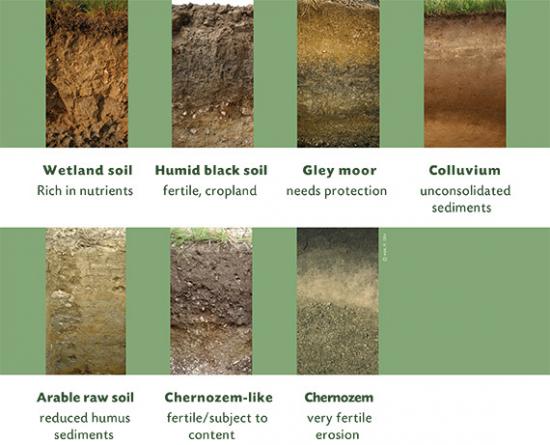Lassee Edible Landscape
SOILS - SKIN OF OUR EARTH
"Soils are the live uppermost section of the upper part of the earth's crust. They range from several centimetres to several tens of metres in thickness compared to a thickness of the earth's crust of 5 to 40 kilometres."
"Soils belong to the most precious and, hence, most protection-worthy goods of mankind."
Agricultural district authority and the municipality of Lassee.
Agriculture Textbook: "Lehrbuch der Bodenkunde", Scheffer/Schachtschabel 2016
The 7 types of soil in the district of Gänserndorf

Soils cannot be multiplied.
It takes at least one hundred years for one centimetre of soil to develop from rock through decomposition processes. Biomass that dies in winter and decays is responsible for constant humus formation. The fertile soils of Central Europe were formed after previous ice ages, the last of which ended approximately 12,000 years ago. This means that our soils are between 5,000 and 150,000 years old. Thanks to their humus and mineral content, they are fertile and provide the foundation for agriculture. The tropics are home to the oldest soils of our planet, which are between 70 and 80 million years of age. Over the course of millions of years, their minerals have been washed into the oceans via rivers, making them salty as a result. Because of the warm climate, the nutrients form part of a continuous cycle. If the trees and shrubs are subject to extensive felling, the ground will become fallow und be swept away by the wind or washed out by rainfalls. A similar result occurs in our case if soils are rendered fallow due to radical felling and frequent ploughing. The slowly established fertility of the soils will then, within a very short time, be lost due to wind erosion and heavy rainfalls. Only a richly structured landscape with hedges, groups of trees, and field and meadow margins can counteract this effect.
The soil is alive.
A large variety of soil organisms maintains life on the earth's surface. They control and regulate entire ecosystems by processing accruing organic substance and hence supplying plant nutrients such as nitrogen and carbon for the material lifecycle. Microorganisms also help to improve the soil structure and make sure that humus-rich soil can develop, as well as the resulting plants and landscapes. A layer of 5 centimetres of grassland soil can house up to 250 kilograms of fungal mycelia per hectare and up to 10,000 different species.

04.11.2025
EUSDR PA10: 12th Danube Participation Day in Sarajevo
mehr ...30.10.2025
Online-Präsentation BBK-Projekt CNSoil - Zwischenergebnisse
mehr ...07.10.2025
CatchHedge - Potenziale von Hecken im Zeichen des Klimawandels
mehr ...16.+17.09.2025
32nd Conference of the Danube Region
mehr ...12.09.2025
Grundlagen der professionellen Bio-Mandel-Produktion
mehr ...10.09.2025
Agroforst u. Marktgärtnerei, Symbiose
mehr ...05.09.2025
Regionales Wiesensaatgut gewinnen mit dem Wiesensamenernter
mehr ...25.06.2025
Feldtag - StripTill im Bio-Mais im Trockengebiet
mehr ...25.06.2025
Seminar: Wildbienen- und Nützlingsförderung im Biolandbau
mehr ...24.06.2025
BOKU Green Plate Forum 3.0
mehr ...24.06.2025
Die Maulbeere - Kultur, Produktion u.Verwendung
mehr ...17.06.2025
Frühjahrstagung Österr. Gesellschaft für Agrar- und Umweltrecht (ÖGAUR)
mehr ...13.06.2025
Seminar: Artenvielfalt in Ackerbauregionen fördern
mehr ...03.06.2025
Seminar: Keine Angst vor der Ackerdistel
mehr ...03.06.2025
Agroforstsysteme: Anbau-Modelle der Zukunft
mehr ...20.05.2025
IDM-Generalversammlung 2025
mehr ...15.05.2025
Seminar: Unkräuter/Beikräuter erkennen und als Zeigerpflanzen nutzen
mehr ...13.+14.05.2025
Bodenforum Österreich - Frühjahrstreffen
mehr ...04.05.2025
Tageskurs: Perma-Veggies - Mehrjähriges Gemüse und essbare Stauden
mehr ...03.05.2025
Waldgärten-Exkursion
mehr ...


